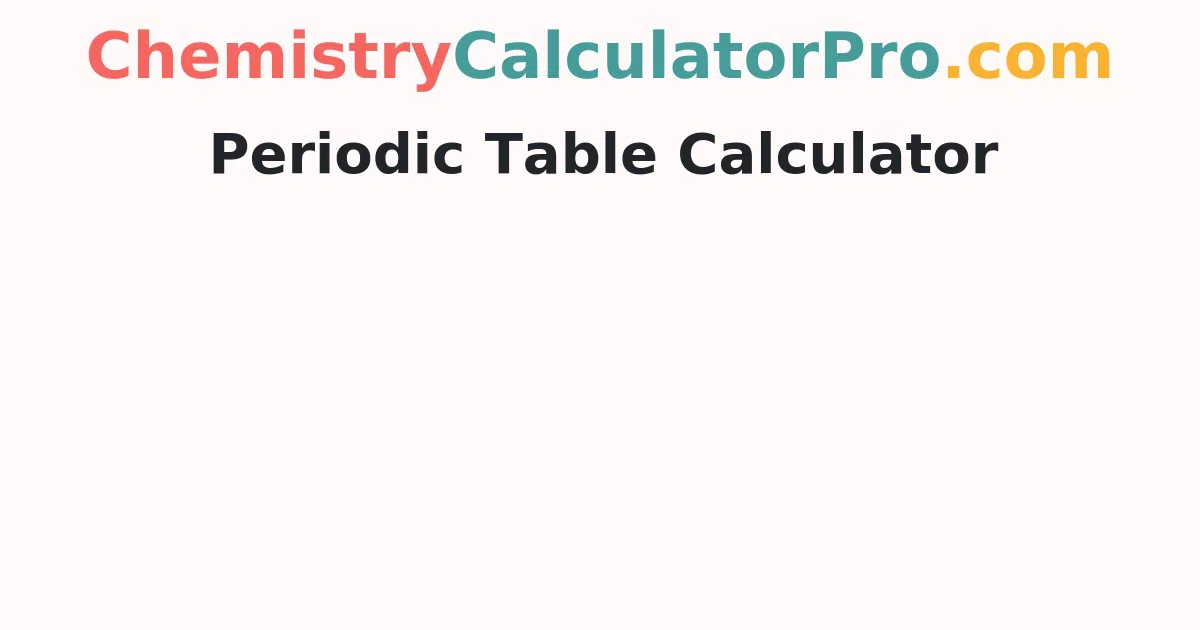Periodic Table Calculator
Periodic Table Calculator gives output Chemical element details like atomic weight, atomic number, atomic properties, nuclear properties, electromagnetic properties, invented by, number of isotopes etc. Just place your mouse pointer on the element name then automatically it will display the entire information of the particular element .
| solid | liquid | Periodic Table | gas | synth | |||||||||||||||
| Name:Invented By: | |||||||||||||||||||
|
1
H |
AtomicWeight: Melt|Boil(C): |
2
He |
|||||||||||||||||
|
3
Li |
4
Be |
Shell: Isotopes: |
5
B |
6
C |
7
N |
8
O |
9
F |
10
Ne |
|||||||||||
|
11
Na |
12
Mg |
Orbital: SpecificGravity: |
13
Al |
14
Si |
15
P |
16
S |
17
Cl |
18
Ar |
|||||||||||
|
19
K |
20
Ca |
21
Sc |
22
Ti |
23
V |
24
Cr |
25
Mn |
26
Fe |
27
Co |
28
Ni |
29
Cu |
30
Zn |
31
Ga |
32
Ge |
33
As |
34
Se |
35
Br |
36
Kr |
||
|
37
Rb |
38
Sr |
39
Y |
40
Zr |
41
Nb |
42
Mo |
43
Tc |
44
Ru |
45
Rh |
46
Pd |
47
Ag |
48
Cd |
49
In |
50
Sn |
51
Sb |
52
Te |
53
I |
54
Xe |
||
|
55
Cs |
56
Ba |
57
La |
72
Hf |
73
Ta |
74
W |
75
Re |
76
Os |
77
Ir |
78
Pt |
79
Au |
80
Hg |
81
Tl |
82
Pb |
83
Bi |
84
Po |
85
At |
86
Rn |
||
|
87
Fr |
88
Ra |
89
Ac |
104
Rf |
105
Db |
106
Sg |
107
Bh |
108
Hs |
109
Mt |
110
Uun |
111
Uuu |
112
Uub |
113
Uut |
114
Uuq |
||||||
| Lanthanides |
58
Ce |
59
Pr |
60
Nd |
61
Pm |
62
Sm |
63
Eu |
64
Gd |
65
Tb |
66
Dy |
67
Ho |
68
Er |
69
Tm |
70
Yb |
71
Lu |
|||||
| Actinides |
90 Th |
91 Pa |
92 U |
93 Np |
94 Pu |
95 Am |
96 Cm |
97 Bk |
98 Cf |
99 Es |
100 Fm |
101 Md |
102 No |
103 Lr |
|||||
Periodic Table - Definition
Periodic table is a tabular display of the chemical elements which were arranged by their atomic number, electronic configuration and recurring chemical properties. The structure of the table shows periodic table trends. The seven rows of the table called periods generally have metals on the left side and nonmetals on the right side.
The eighteen columns are called group containing elements with similar chemical behaviour. 118 elements are naturally occurring elements and the rest are made.Elements arranged in left to right, top to bottom in increasing order of atomic number. The elements in the same group have the same valency and chemical properties.
Uses of Periodic Table
- By using a periodic table we can distinguish between metals, non metals, and metalloids.
- By using this we can measure electronic configuration of elements.
- Using this we can determine melting and boiling points of elements.
- By using a periodic table we can determine the atomic radius and ionic radius of an element.
- We can know about blocks of elements and also can measure atomic number, electronic configuration and ionization energy of elements.
Lanthanides are the rare-earth elements, they are a group of elements from lanthanum (Atomic number 57) to Lutetium ( Atomic number 71). So there are 15 elements in the lanthanide series. Each element in the lanthanide series has a valency of +3. Lanthanides belong to the 6th period and 3rd group(1st group of d-block).
If you would like to learn more about the other chemical calculator that gives instant results, stay tuned to Chemistrycalculatorpro.Com
FAQ’s on Periodic Table Calculator
1. How many elements are there in the periodic table?
Periodic table has 118 elements.
2. What are Inert gases in the periodic table?
Inert gases are Helium, Neon, Argon, Krypton, Xenon, radon and Oganesson.
3. What is meant by periodic table?
Periodic table consists of elements and are arranged in increasing order of Atomic weight.
4. What is the range of actinide elements?
Atomic numbers ranging from 90 to 103 are actinide elements.
5. What are 4 blocks of periodic table?
S-block, P-block, d-block, f-block are named after their orbital characteristics.
